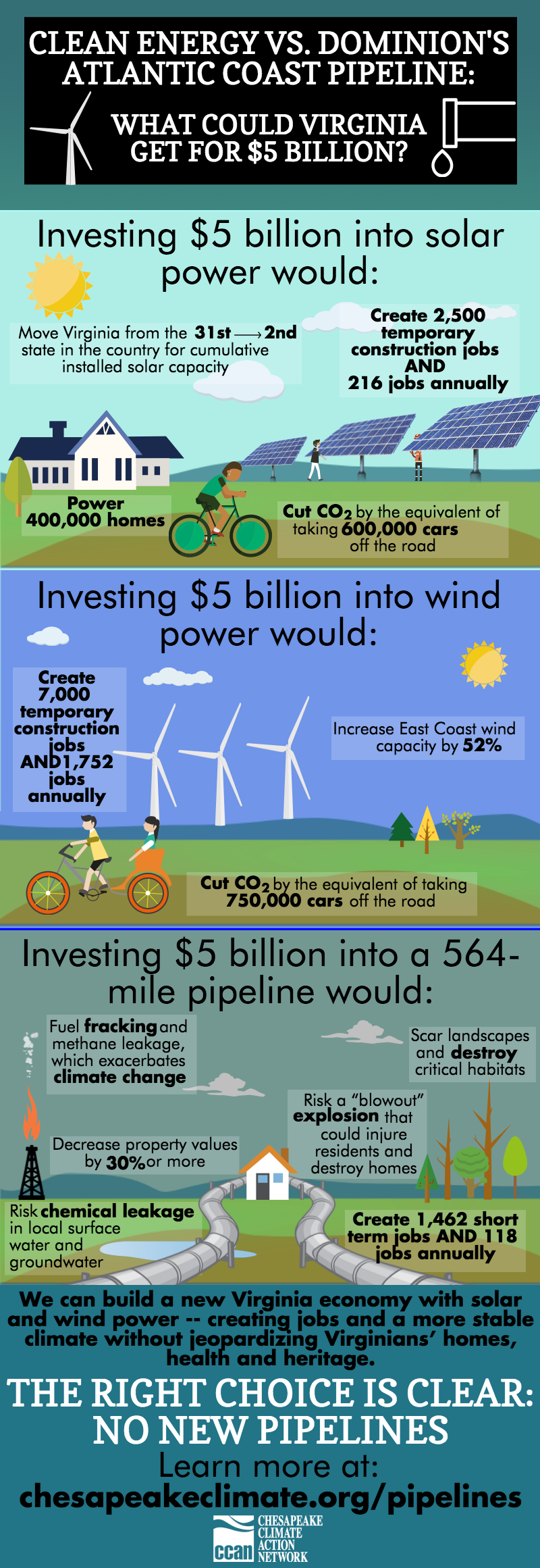By Monique Sullivan and Chad Oba
Monique Sullivan is Field Director at the Chesapeake Climate Action Network. Chad Oba is Chair of Friends of Buckingham County. This piece also ran on the blog Blue Virginia.
Scroll down for complete infographic.
Last month, over the continuing objections of landowners, Dominion Resources filed its official application with the Federal Energy Regulatory Commission to build its proposed 564-mile, $5.1 billion Atlantic Coast Pipeline. Now it’s FERC’s job to determine if Dominion’s pipeline serves a real public need and is the best option—given available alternatives—to satisfy that need.
Those are very important questions, especially when you consider that Dominion’s pipeline is the largest of four new gas pipeline projects proposed across the Appalachian and Blue Ridge Mountains of Virginia and West Virginia. The 300-mile Mountain Valley Pipeline is expected to file its application with FERC any day now. If both projects move forward, Virginians will face an unprecedented expansion of natural gas infrastructure. But for what end?
We know the case Dominion will make: that we need a more than $5 billion pipeline for the energy and jobs it could bring to Virginia. Those are both real public needs. But is a massive new conduit for a dirty, volatile fossil fuel the best way to meet them? What if, instead, Dominion spent its billions on a build-out of clean energy alternatives? A recent analysis by the Chesapeake Climate Action Network suggests this would be the far better deal for Virginia.
Using U.S. Energy Information Administration data and National Renewable Energy Laboratory modeling, we found that the more than $5 billion Dominion is proposing to spend on the Atlantic Coast Pipeline could conservatively fund the installation of enough solar panels [1] to power over 400,000 Virginia homes [2]. Installing and maintaining this solar industry would create 2,500 temporary construction jobs and support 216 permanent jobs annually [3].
This investment would leapfrog Virginia ahead of our neighbors, making us the number 2 state for cumulative installed solar capacity in the country, behind California. Right now we’re number 31.
If we invested the money in wind power projects, Dominion could fund the installation of enough wind turbines [4] to power nearly 500,000 Virginia homes [5]. Building this new industry would create over 7,000 temporary construction jobs and support 1,752 permanent jobs annually [6].
By contrast, the Dominion-commissioned Chmura analytical economy report predicted that the Atlantic Coast Pipeline would support 118 permanent jobs annually. And we have no guarantees about how much actual energy Virginians would get from the pipeline. The project would have a spur into Hampton Roads and potentially to other proposed Dominion gas plants, but the pipeline’s ultimate destination is North Carolina.
What else do we get for Dominion’s $5 billion investment in natural gas? We’d get a 75-foot-wide permanent scar through family farms and the heart of the East Coast’s remaining wild landscape, including the George Washington National Forest and the Appalachian Trail. We’d get significant safety risks, like the pipeline “blowout” in Appomattox, Virginia in 2008 that reportedly created a 1,000-foot high fireball, injured five residents, and damaged 95 homes. We’d get emissions of methane leaked from the pipeline and from the process of hydraulic fracturing, or “fracking,” used to extract the gas. A growing number of studies show that reliance on fracked gas disrupts the climate on par with coal. So, we’d also get more climate impacts wreaking havoc on our families.
Investing that $5 billion in solar or wind power in Virginia would reduce carbon emissions [7] at a rate equal to taking over 600,000 or nearly 750,000 cars off the road [8] respectively. With rising seas already stranding Norfolk residents at high tide, freak flash floods damaging businesses in Roanoke, and weather extremes stressing our food supply everywhere, Virginia needs energy investments that will help stabilize—not further disrupt—our climate.
The comparison we’re making is not an abstract one. Buckingham County is at the center of this debate over Virginia’s energy future. The company Atlantic Coast Pipeline LLC has purchased land to build a 41,000-horsepower compressor station—a facility that keeps the gas pressurized as it travels—in Buckingham County. Meanwhile, Virginia Solar LLC is applying for a permit to build a 20-megawatt solar energy facility just a few miles away. Scientific studies link air pollution from compressor stations to numerous negative health conditions. Add on groundwater contamination, unsafe noise levels, wildlife habitat loss, lowered property values and risk of on-site accidents, and the choice for Buckingham County residents is clear.
The choice should be clear for all of us. The clean energy alternative truly beats gas when you take the long view—which is part of FERC’s job. Wind and solar are mature technologies that are getting cheaper every day. In fact, utility-scale solar is now beating natural gas on price alone in many areas of the country. In applying for their permit, Virginia Solar noted that solar-generated electricity is rapidly becoming competitive with other forms of energy.
When it comes down to it, Dominion’s Atlantic Coast Pipeline is far from a necessary or prudent way to meet our energy needs. FERC must factor in the readily available alternative path to laying hundreds of miles of new gas pipeline through Virginia, and ultimately deny Dominion’s application. And Virginia’s leaders, especially Governor Terry McAuliffe, should stop stumping for it.

Click here to share on Facebook
Click here to share on Twitter
Sources:
1. “Lazard’s Levelized Cost of Energy Analysis – Version 8.0.” Lazard. Sep. 2014. <http://gallery.mailchimp.com/ce17780900c3d223633ecfa59/files/Lazard_Levelized_Cost_of_Energy_v7.0.1.pdf> Slide 11 estimates that the capital cost of utility-scale solar PV is $1,500/kilowatt.
2. U.S. Energy Information Administration. “2013 Average Monthly Bill- Residential.” 2014, <http://www.eia.gov/electricity/sales_revenue_price/pdf/table5_a.pdf> Based on capital costs assumptions, and a median 20.3% capacity factor, we assume a solar output of 5,631,220 megawatt-hours. The average monthly electricity usage in Virginia is 1,156 kilowatt-hours.
3. National Renewable Energy Laboratory. “About JEDI Photovoltaics Model.” N.p., n.d. Web. 13 Oct. 2015. <http://www.nrel.gov/analysis/jedi/about_jedi_pv.html>. Calculated using the National Renewable Energy Laboratory’s Jobs and Economic Development Indicator (JEDI) “Scenario_PV_Model_rel._PVS3.24.14”
4. “Lazard’s Levelized Cost of Energy Analysis – Version 8.0.” Lazard. Sep. 2014. <http://gallery.mailchimp.com/ce17780900c3d223633ecfa59/files/Lazard_Levelized_Cost_of_Energy_v7.0.1.pdf> Slide 11’s high estimate of the capital cost of wind energy is $1,800/kilowatt.
5. U.S. Energy Information Administration. “2013 Average Monthly Bill- Residential.” 2014, <http://www.eia.gov/electricity/sales_revenue_price/pdf/table5_a.pdf> Based on capital costs assumptions, and a 30% capacity factor, we assume a solar output of 6,935,000 megawatt-hours. The average monthly electricity usage in Virginia is 1,156 kilowatt-hours.
6. National Renewable Energy Laboratory. “About JEDI Photovoltaics Model.” N.p., n.d. Web. 13 Oct. 2015. <http://www.nrel.gov/analysis/jedi/about_jedi_pv.html>. Calculated using the National Renewable Energy Laboratory’s Jobs and Economic Development Indicator (JEDI) “Land-based Wind Model rel. W07.08.15”
7. Lucas, Kevin. EmPOWER and RPS Progress Update. Maryland Energy Administration, 21 May 2015. <http://www.mde.state.md.us/programs/Marylander/Documents/MWGHandout3MEA05212015.pdf>. Slide 15 estimates, based on the EPA 111(d) Base Case analysis that “PJM” — the electricity grid region in which Virginia is located — will have a carbon intensity of 1,124 lbs per megawatt-hour.
8. U.S. Environmental Protection Agency. “GHG Equivalencies Calculator – Calculations and References.” N.p., n.d. Web. <http://www2.epa.gov/energy/ghg-equivalencies-calculator-calculations-and-references#vehicles>





